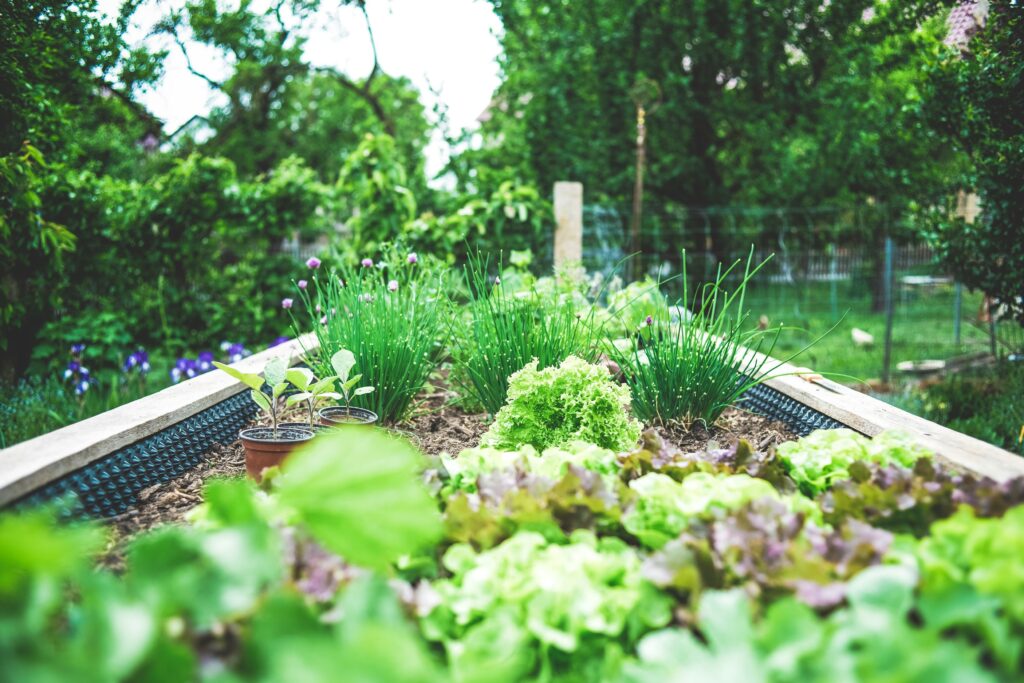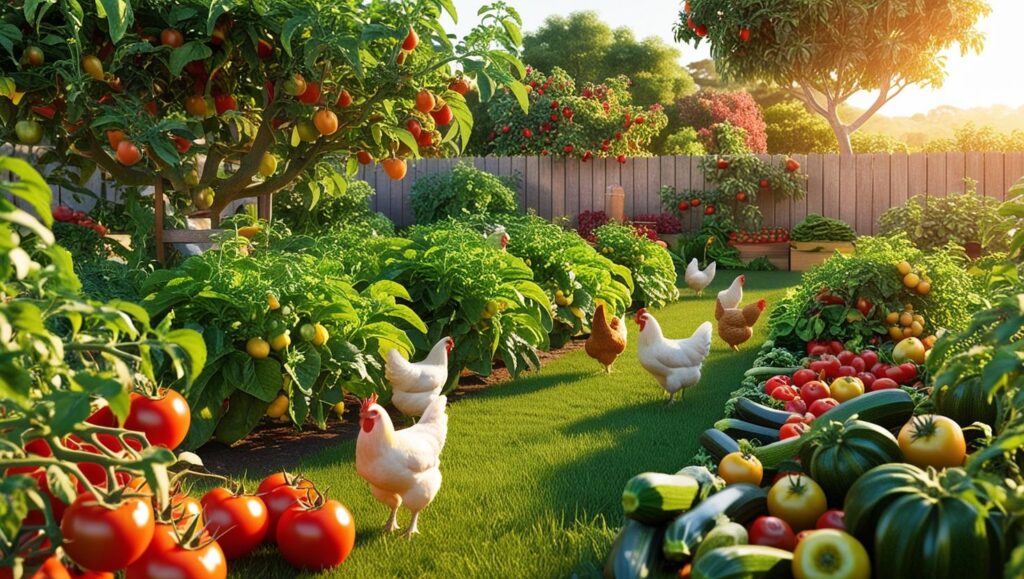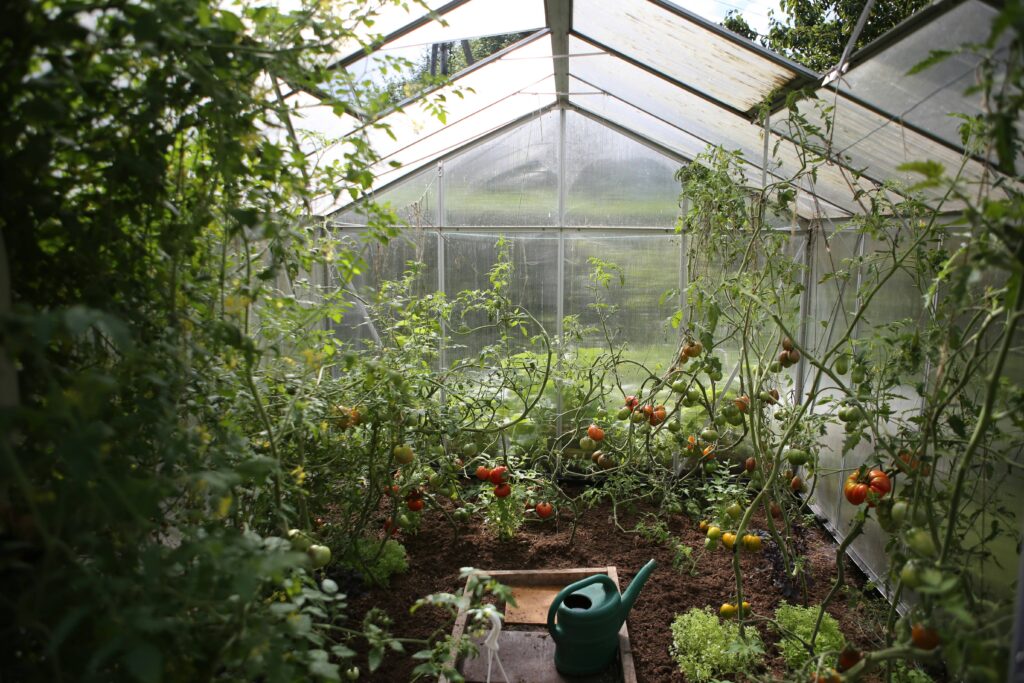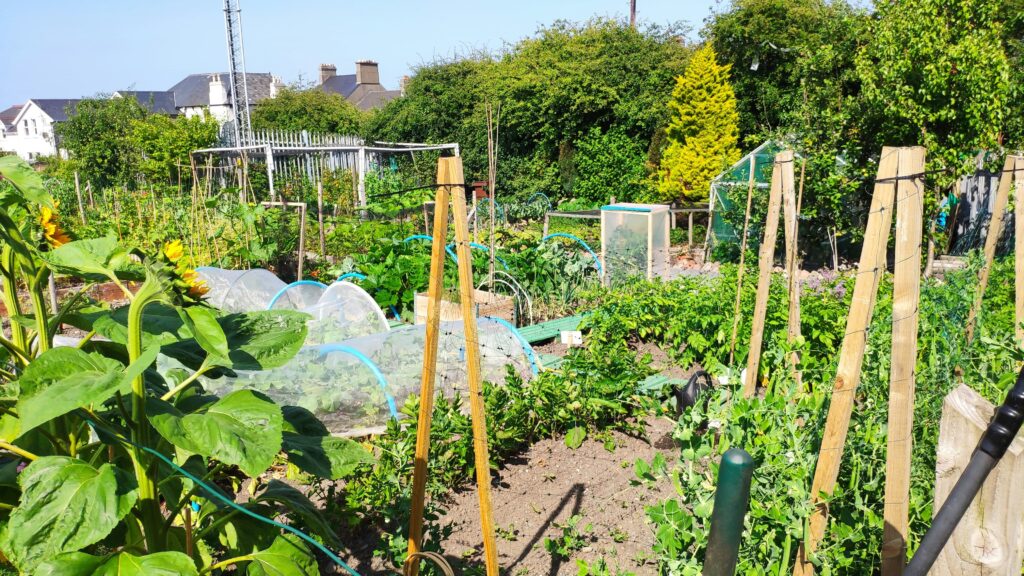“How much land to be self sufficient?” It’s a question that’s grown from a niche curiosity into a mainstream search, especially as more Australians look for ways to reduce living costs, grow their own food, and gain independence from unstable supply chains. But whether you’re in a suburban backyard or eyeing a rural block of bushland, the answer depends less on the number of acres and more on how you use them.
Before diving into numbers, it’s important to define what “self-sufficient” actually means to you. For some, it’s about growing most of their own food. For others, it includes meat production, renewable energy, water harvesting, even income generation from a smallholding. Your land needs will vary depending on which of these goals you’re aiming for — and how intensively you’re prepared to manage them.
At its most basic, self-sufficiency in food for a single person can be achieved on as little as 200–400 square metres of well-managed land with fertile soil and good rainfall. That’s around the size of a modest suburban backyard. Add in small livestock like chickens or ducks, vertical gardening, composting, and rainwater capture, and it’s possible to grow a significant proportion of your own food without ever leaving city limits.
However, if you’re aiming for full-spectrum self sufficiency — think grains, meat, dairy, fuelwood, fibre — the scale increases substantially. For an average Australian family of four, estimates range from 1 to 5 acres of productive land, depending on climate, land quality, and your chosen methods.So how much land is needed for a self-sustaining farm? Let’s break it down by lifestyle, inputs, and outputs — and look at real-world examples to help you map your own journey to independence.

Land Requirements by Type of Food Production
To understand how much land for self sufficiency is really needed, it helps to break things down by category — vegetables, grains, fruit, meat, and dairy. Each of these systems has its own space, time, and resource demands.
Vegetables
A well-planned vegetable garden is one of the most space-efficient ways to begin a self-sufficient lifestyle. Using intensive gardening methods like square-foot gardening, no-dig beds, or raised wicking beds, you can grow a surprising amount in a small space.
- Space needed (per adult): 40–100 m²
- Common crops: Tomatoes, beans, lettuce, carrots, potatoes, sweet corn
- Annual yield potential: ~200–300kg of fresh produce
- Time required: 3–5 hours/week
- Best suited for: Urban blocks, backyards, small acreage
In mild Australian climates like coastal NSW, Victoria, and parts of SA, you can garden year-round. A family of four aiming for 70–80% of their vegetable needs might require around 400–500 m² of growing area, especially if practicing crop rotation and composting to maintain soil health.
Fruit and Nut Trees
Fruit trees are less labour-intensive than annual vegetables but require more space and time to establish. Dwarf varieties and espalier methods allow you to grow apples, pears, plums, and citrus in compact spaces.
- Space needed (per person): ~50–100 m²
- Common species: Apple, lemon, olive, plum, fig, almond
- Yield: 50–150kg/year depending on species and maturity
- Time to maturity: 2–5 years
- Best suited for: Backyards, rural plots, orchards
A small mixed orchard of 8–12 trees can produce hundreds of kilograms of fruit annually — more than enough for a family, with surplus for preserving or trade.
Grains and Staple Crops
This is where the land needs jump. Growing enough wheat, oats, corn, or barley to supply your household with flour, porridge, or animal feed takes planning — and space.
- Space needed (per adult): 500–1,000 m²
- Yield: 200–300kg of grain/year
- Key considerations: Machinery for threshing and milling, pest control, crop rotation
- Best suited for: Semi-rural or rural blocks, >1 acre
According to Homesteading Family, one person can grow a year’s worth of wheat on just 90m² — but that’s under ideal conditions with high-yield varieties and no losses. More realistically, ¼ to ½ acre (1,000–2,000 m²) per family is a comfortable benchmark, especially if integrating legumes like soy or chickpeas.
Meat and Dairy Production
When people picture a self-sustaining farm, livestock often features prominently — chickens for eggs, goats for milk, maybe even a cow or two. But while animals add diversity and nutrition, they also demand more space, water, and feed. Let’s explore how much land is needed for different types of meat and dairy production in the Australian context.
Chickens (Eggs and Meat)
Chickens are the gateway animal for many aspiring homesteaders — and for good reason. They’re small, manageable, and produce both meat and eggs on minimal land.
- Space needed: 0.2–0.5 acres (~800–2,000 m²) for 6–10 birds with rotational grazing
- Egg yield: 250–300 eggs per hen per year
- Meat yield: ~2kg per bird (meat breeds)
- Supplemental feed required: Yes
- Best suited for: Small rural blocks, larger suburban yards
If you integrate chickens into a garden system — allowing them to weed, fertilise, and manage pests — you’ll get more value per square metre. A family of four can be well-supported by 6–8 laying hens, and 10–20 meat birds raised seasonally.
Goats (Milk and Meat)
Goats are compact, hardy animals ideal for small-acreage farming. They’re browsers (not grazers), so they do well in rougher terrain with shrubs, trees, and weeds.
- Land needed per goat: 0.1–0.25 acres (400–1,000 m²) per goat (rotational paddocks)
- Milk yield: 2–4L/day (milking breeds)
- Meat yield: ~18–25kg per carcass
- Key benefits: High ROI in small herds, easier handling than cattle
- Challenges: Escape artists, require strong fencing, dislike wet climates
If you plan to rely heavily on goat’s milk or meat, a ½ acre rotational system with shelter and browse areas can sustain 2–4 goats, depending on your climate and whether you’re supplementing with hay.
Sheep
Sheep are more grazing-focused than goats and need reliable pasture or regular feed. They’re great for meat, wool, and in some cases, milk — though dairy sheep are less common in Australia.
- Land needed per sheep: 0.25–0.5 acres (1,000–2,000 m²), ideally rotated
- Meat yield: ~20–30kg per carcass
- Wool: 2–6kg per sheep annually
- Milk (dairy breeds): Up to 2L/day
- Best suited for: 1+ acre properties with pasture or grazing availability
A flock of 3–5 sheep on an acre can comfortably provide a year’s worth of meat for a family, with extra value through wool and lambing.
Cows (Dairy and Beef)
This is where self-sufficiency starts to require serious space. Cattle need larger paddocks, more water, and substantial feed — but can supply a full household’s dairy and red meat needs.
- Land needed per cow: 1–2 acres (~4,000–8,000 m²) of good pasture
- Milk yield: 10–20L/day (dairy breeds)
- Meat yield: 150–250kg per carcass
- Feed requirement: High; often need hay during dry seasons
- Best suited for: 2+ acre properties with pasture access
A single milking cow can provide over 5,000 litres per year, which is more than enough for a family. For beef, some families raise a single steer on rotation or in shared paddocks.

Land Size Scenarios in Australia: What’s Realistic for Self-Sufficiency?
In Australia, the question of how much land do you need to be self sufficient has a different answer depending on where you live — especially when average suburban backyards are shrinking. With new housing developments pushing block sizes down to as little as 50 m² of usable backyard, expectations need to be grounded in what’s possible, not idealised.The sections below break down achievable levels of self-sufficiency based on real Australian block sizes and offer practical insights for those starting with very little, as well as those considering a lifestyle change on acreage.
Urban Backyards: 50–350 m² of Usable Outdoor Space
Perfect for: Suburban families looking to cut grocery bills and build resilience.
This is where most Australians are starting — whether it’s a courtyard in a townhouse or a modest backyard in an older suburb. Full self-sufficiency isn’t feasible here, but partial self-sufficiency certainly is.
What you can realistically do:
- Vertical gardens and raised beds for herbs, lettuce, tomatoes, and seasonal veg
- 2–3 hens (if local council allows) for eggs and compost
- Worm farms and bokashi bins for food waste management
- Rainwater tanks (e.g. 1,000–2,000L) for garden irrigation
- Potted fruit trees (dwarf varieties) — lemon, fig, olive, etc.
Yield potential:
- Most of your fresh herbs and salad greens
- 2–3 eggs per day
- Some seasonal vegetables and fruits
Limitations:
- No space for ruminants or calorie-dense crops like potatoes or corn
- Reliant on external sources for meat, dairy, and bulk carbohydrates
- Shade, privacy walls, and soil quality can impact yields
Bottom line: A realistic goal is 10–25% food self-sufficiency from an urban backyard — especially in terms of greens, herbs, and eggs. It’s a strong foundation, especially when paired with local food networks or community gardens.
Suburban Blocks with Larger Gardens: 400–1,000 m²
Perfect for: Households aiming for serious food production, including small animals.
Older suburbs and regional towns often offer blocks of this size — with the space to go beyond just veggies and into small livestock, storage, and even basic permaculture systems.
What you can realistically do:
- Larger vegetable gardens (50–100 m² of beds)
- 4–6 chickens or ducks for eggs and pest control
- 2–3 fruit trees plus vines or berries along fences
- Beekeeping, if local zoning permits
- Quail, rabbits, or guinea pigs for meat (low footprint, high protein)
- Greywater reuse for irrigation
Yield potential:
- 50–70% of your vegetables and fruit
- Most of your eggs
- Some animal protein (if you’re willing to breed or process)
- Compost and fertility management on-site
Limitations:
- Still limited for grazing animals like goats or sheep
- Water availability and sun exposure can be challenges
- Requires time and seasonal planning
Bottom line: These properties can reach 30–60% self-sufficiency, especially when layered with smart garden design and intensive management. It’s a sweet spot for Australian households wanting to eat well and reduce their reliance on supermarkets without moving off-grid.
Small Acreage: 1–5 Acres (≈ 4,000–20,000 m²)
Perfect for: Families who want full food independence — including meat, dairy, and some surplus.
Outside metro areas, especially in peri-urban zones or regional towns, this is the range where full self-sufficiency becomes possible. With 1–5 acres, you can implement rotational grazing, food forests, and animal housing without compromise.
What you can realistically do:
- Run goats, sheep, or a house cow for milk and meat
- Keep chickens, ducks, geese or even turkeys
- Grow staple crops like potatoes, corn, pumpkins, beans
- Plant 20–50 fruit and nut trees
- Build infrastructure (sheds, water tanks, shelters)
- Store water and compost at scale
- Develop solar systems for partial off-grid resilience
Yield potential:
- 100% of vegetables and most fruit
- Full egg and poultry meat supply
- Dairy, depending on animal choice
- Some grain or feed production
Bottom line: With proper planning and seasonal rotations, 1–5 acres is enough to support a family of 3–5 with full food self-sufficiency, including animal protein. This is a practical goal for many rural Australians who want independence from the industrial food system.

How Much Land is Needed for Self Sufficiency by Food Group
It’s easy to throw out numbers like “five acres” or “one hectare,” but the real question is: what are you growing on that land — and for whom?
To work out how much land is needed for a self-sustaining farm or household, you need to break it down by food category. The right mix will depend on climate, preferences, and how much time you can dedicate to growing and processing food.
Below is a rough guide based on average Australian consumption patterns, assuming one adult and a moderate level of self-sufficiency effort (with animals, vegetables, and some grain).
Vegetables and Greens
Land required: ~100–200 m² per person
Vegetables are the easiest place to start. With well-designed beds, crop rotation, compost, and irrigation, most Australians can grow enough seasonal vegetables for year-round consumption.
| Vegetable Type | Area Estimate per Person | Notes |
| Leafy greens | 10–20 m² | Quick-growing, high yield |
| Root vegetables | 20–30 m² | Think carrots, beets, radishes |
| Potatoes & pumpkins | 30–40 m² | Calorie dense, storage friendly |
| Tomatoes & legumes | 20–30 m² | Can be trellised to save space |
| Alliums (onion, garlic) | 10–15 m² | Easy to grow and store |
Minimum total space: 100–150 m² per person
Ideal for security: 200 m²+ per person (to allow for failures, storage crops, and seed saving)
Grains and Carbohydrates
Land required: ~500–1,000 m² per person (for basics like wheat, corn, oats, etc.)
Grains are where self-sufficiency starts to stretch — not because they’re hard to grow, but because they take space, time, and storage infrastructure. That said, it is doable. In fact, many Australians grow corn or wheat on a small scale for chicken feed or milling.
| Grain Crop | Area for Annual Needs | Notes |
| Wheat | ~300 m² | For ~50kg of flour per year |
| Corn | ~200 m² | Dual purpose: food + animal feed |
| Oats/Barley | ~150 m² | Can double as feed for livestock |
| Potatoes | ~50 m² | High-calorie alternative to grain |
Alternative options:
- Buy staples in bulk from local co-ops
- Grow some grains (like corn or sorghum) for animal feed or bartering
- Supplement with high-yield starches like sweet potato or yacon
Animal Protein: Meat, Eggs and Dairy
Land required: varies greatly — from 50 m² to several acres
This is where the biggest differences arise. Keeping chickens for eggs requires almost no land. Raising beef cattle requires hectares. The key to self-sufficiency here is choosing low-footprint animals and making the most of vertical or stacked systems.
Eggs and Poultry (e.g. chickens, ducks, quail)
| Animal | Min. Land Needed | Output per Year |
| Chickens | 1–2 m² per bird + 4–6 m² run | 200–280 eggs/bird |
| Ducks | 2–3 m² per bird with pond | 150–250 eggs/bird |
| Quail | 0.5–1 m² per bird | 250+ eggs/bird (space-efficient) |
Recommendation: 3–5 hens per adult provides a stable egg supply.
Meat Animals (e.g. rabbits, goats, pigs)
| Animal | Min. Land Needed | Notes |
| Rabbits | 2–3 m² per trio | High yield, small footprint, quiet |
| Pigs | ~100 m² per pig | Requires strong fencing, very efficient |
| Goats | 250–500 m²+ | Dual use: milk and meat |
| Sheep | 0.5–1 acre per 2 sheep | Grazing required, wool bonus |
| House cow | 1–2 acres | Daily milking, high return on effort |
| Beef cattle | 2–5 acres per head | Long rotation, high space needs |
General land rule of thumb for protein:
- Urban/Suburban: Eggs and rabbits are your best friends.
- Small Acreage (1–5 acres): Goats, poultry, maybe a small cow or 1–2 sheep.
- Large Acreage (5+ acres): Full rotations with cattle, pigs, and grazing animals are feasible.

Matching Land to Lifestyle
By now, it should be clear that there is no single answer to the question, “how much land do you need to be self sufficient?” The better question might be: what kind of self-sufficiency are you aiming for? Because the path to self-sufficiency is not binary — it’s a sliding scale, and where you sit on it depends on your personal goals, available resources, and tolerance for labour.
If your aim is to reduce your grocery bills and feel more connected to your food, a backyard garden of 250–350m² (the average size for many Australian homes) can already offer significant returns. Add vertical growing systems, chickens for eggs, and a compost heap, and you’re well on your way to a productive suburban setup.
For others, especially those looking to get off-grid, raise livestock, and produce enough food to support multiple people, you’ll need to look further afield. In this case, land ranging from 1–5 acres can offer enough flexibility to balance livestock, grains, vegetables, fruit trees, and perhaps even honey or aquaponics.
For those wanting total independence — grain, meat, dairy, vegetables, energy, and even fuel — the number edges closer to 10–20 acres, depending on your methods and climate zone. But this level of commitment often requires multiple adults working full-time, and even then, trade-offs are necessary.
A Caution on Romanticising Land Size
The bigger-is-better mentality can lead new homesteaders into trouble. Land alone doesn’t guarantee productivity. Infrastructure, water access, knowledge, and time are all critical. It’s often smarter to master a small piece of land and expand if needed than to be overwhelmed by managing more than you can handle.
Similarly, climate matters. In parts of Queensland or northern NSW, lush rainfall allows for year-round growth on less land. In South Australia or WA’s drier zones, you may need more land just to grow the same amount of feed or food.
Financial Considerations
With land prices in Australia continuing to rise, purchasing 5–10 acres within an hour of a major city may be cost-prohibitive for many. For example:
- In outer Melbourne or Sydney suburbs, land can exceed $800,000+ for 5 acres with services.
- In regional areas, such as Gippsland or northern Tasmania, you can often find 10 acres between $250,000–$400,000.
- In rural Queensland or South Australia, prices may drop further but come with less infrastructure and greater remoteness.
This is why many aspiring homesteaders are choosing to either:
- Start small on their suburban block, building skills and systems;
- Share land with others in co-op style arrangements;
- Or transition gradually, maintaining income from a city job while developing rural land part-time.
Always factor in fencing, water tanks, shelter, and irrigation — these setup costs can rival the land price itself if not carefully planned.
Planning for Australian Conditions
Whether you’re working with a quarter-acre or twenty, Australian conditions demand thoughtful planning. Here are some final considerations:
- Bushfire risk: Learn about BAL (Bushfire Attack Level) ratings if you’re in a rural area.
- Water collection: With dry seasons and unpredictable rainfall, water storage is crucial. Every 1,000m² of roof can collect ~1,000L per 1mm of rain.
- Native pests: Wallabies, kangaroos, cockatoos and possums all love fresh produce.
- Zoning and restrictions: Always check with your local council. Some acreage blocks prohibit livestock or commercial food production.
Building a Scalable Plan
The best way to approach self-sufficiency is in layers. Start by asking:
- What food can I grow or raise this season?
- What inputs (like compost, mulch, feed) can I create myself?
- What skills do I need to learn next (e.g., pruning, butchering, preserving)?
Then map your land, however large or small, and build around your goals. The most resilient homesteads aren’t the ones with the most land, but the ones that use their land with the most care and creativity.
In Summary, How Much Land Do You Need to be Self-Sufficient?
| Type of Self-Sufficiency | Recommended Land Size (Australia) | Key Activities |
|---|---|---|
| Basic (herbs, some veggies) | <100m² | Pots, vertical gardens, composting |
| Moderate (veggies, eggs) | 250–500m² | Raised beds, chickens, rainwater collection |
| Full Garden + Small Livestock | 1–2 acres | Goats/sheep, bees, food forest |
| Full Food + Feed Independence | 5–10 acres | Cows, grains, orchard, pasture management |
| Off-grid, multi-family farm | 10–20+ acres | Energy, dairy, meat, crops, fodder, fuel |
If you’re just getting started, don’t get hung up on the numbers. Even the smallest plot can produce more than you’d imagine with the right knowledge and intention. Focus first on building systems and habits — then scale up as your land, time, and experience allow.
If you’ve already made up your mind to pursue the self-sufficient part, then maybe you’re looking for good spots to find that ideal parcel of land; make sure you check out our views on the best locations to consider in NSW, Victoria and Queensland and our helpful guide on how to buy a farm if you’re aiming to move rural.


